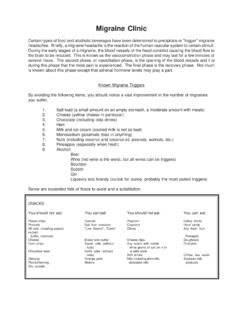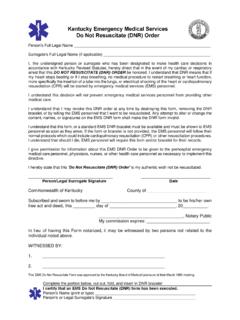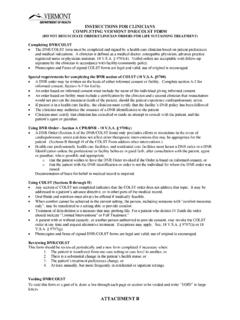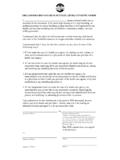Transcription of TEXAS DEPARTMENT OF HEALTH STANDARD OUT …
1 1 TEXAS DEPARTMENT OF HEALTH STANDARD OUT-OF-HOSPITAL DO-NOT-RESUCITATE ORDERS PURPOSE: WHAT DOES THE OOHDNR ORDER DO? Allows patients to direct HEALTH care professionals in the out-of-hospital setting to withhold or withdraw specific life-sustaining treatments in the event of respiratory or cardiac arrest. It is the patient s choice to execute a TDH STANDARD Out-Of-Hospital Do Not Resuscitate (OOHDNR) Order; it cannot be made a requirement for any reason, including the issuance of insurance or the provision of HEALTH care. This OOHDNR Order should be used in addition to the Directive to Physicians and Family or Surrogates (formerly called Living Wills) and Medical Power of Attorney (formerly called Medical Power of Attorney for HEALTH Care) documents. DEFINITIONS There is no time related criteria; 6 months life expectancy. TDH OOHDNR Orders do not apply to known pregnant persons. TDH OOHDNR Orders applies to HEALTH care professionals, including: Physicians Physician Assistants Nurses EMS Personnel Note: A Physician s DNR Order (such as one written by a physician, physician s assistant or a nurse practitioner) may be honored by HEALTH care personnel except for Emergency Medical Services personnel.
2 A licensed nurse or person providing HEALTH care services in an out-of-hospital setting may honor a physician's do-not-resuscitate order. However, EMS personnel shall honor only a properly executed or issued TDH OOHDNR order or proper DNR identification device. An out-of-hospital setting is any setting outside of a licensed acute care hospital in-patient room in which HEALTH care professionals are called for assistance. Among these are: Home HEALTH Hospice Long-term care EMS Schools Malls, restaurants, homes, businesses, etc. Hospital emergency DEPARTMENT , outpatient centers, etc. 2 Hospital emergency departments are included because the patient is not a hospital in-patient at this point; long-term care facilities and the like may also be considered out-of-hospital if the patient is not an in-patient of the hospital. Both general hospitals and specialty hospitals are included in the definition of an acute care hospital. Life sustaining procedures are: Cardiopulmonary resuscitation (CPR) Defibrillation Advanced airway management Artificial ventilations Transcutaneous cardiac pacing Respiratory or cardiac arrest ensues upon the cessation of spontaneous respirations or pulse.
3 WHO CAN EXECUTE THE ORDER? A patient, who is competent, and who is an adult, may execute a written TDH OOHDNR Order at any time. If a patient is incompetent, but previously executed a Directive to Physicians and Family document, the physician may rely on the directive as the patient s instructions to issue a TDH OOHDNR Order. If a patient is incompetent, but previously executed a Directive to Physicians and Family document, the designated proxy may make any decisions required. If a patient is incompetent, but previously executed a Medical Power of Attorney (MPA) document designating an agent, the agent may make any decision required. A patient, who is competent, and who is an adult, may issue a TDH OOHDNR Order by nonwritten communication. The following may execute a TDH OOHDNR Order on behalf of a minor (a person who has not reached their 18th birthday) if the minor has been diagnosed with a terminal or irreversible condition: Parent; Legal guardian; Managing conservator.
4 No one may execute a TDH OOHDNR order for a minor unless the minor has been diagnosed by a physician as suffering from a terminal or irreversible condition. If a patient is comatose, incompetent, or otherwise mentally or physically incapable of communication, the person s legal guardian, proxy or MPA agent may execute a TDH OOHDNR Order. If a patient does not have a legal guardian, proxy or MPA agent, the attending physician and a second physician not involved in treating the patient may execute a TDH OOHDNR Order based on the knowledge of what the patient would have desired. In all cases the desire of a patient who is competent supersedes the effect of a TDH OOHDNR Order. 3 PROCEDURE FOR EXECUTION The patient or the patient s representative is responsible for contacting his or her physician or HEALTH care provider for assistance on executing this order. The attending physician is required to complete the Physician s Statement and also sign the bottom of the form in Section 3.
5 This doctor will document the existence of a TDH OOHDNR Order in the patient s medical record. If the attending physician refuses to execute or comply with the TDH OOHDNR Order, the physician must inform the patient or patient representative and make a reasonable attempt to transfer the care of the patient to a physician who is willing to execute or comply with the order. At the same time and place or at a separate time and place, the patient or patient s representative and the witnesses should complete Sections 1 and 2 and the remainder of the signature lines at the bottom of the form in Section 3. The instructions for the completion of the TDH OOHDNR Order should be referenced during execution of the order. The patient may choose to wear an official ID device. The patient can not be required to wear an official ID device. STANDARDIZED FORM Review the form: Section 1 Patient demographics Section 2 Execution information Witnesses Physician statement Section 3 All signatures repeated.
6 So that the form is available for filing upon the death of the patient, the original or a copy of the form must travel with the patient during interfacility transfers. Upon the death of the patient, the HEALTH care provider having the last patient contact shall file the TDH OOHDNR Order in the patient s medical records. If no HEALTH care provider is present upon the death of the patient and someone other than a HEALTH care provider handles disposition of the body, the document may be retained by the family or returned to the patient s primary HEALTH care provider. HONORING THE ORDER The TEXAS OOHDNR statute specifically states, When responding to a call for assistance, HEALTH care professionals shall honor an out-of-hospital DNR order in accordance with the statewide PATIENT IDENTIFICATION HEALTH care providers identify patients as having a TDH OOHDNR Order when the: Original or copy of the form is present and appears valid, OR patient is wearing an approved ID device.
7 4 PATIENT CARE DOCUMENTATION MUST INCLUDE: Confirmation that a TDH OOHDNR Order was presented and what format was accepted; Any problems accepting the TDH OOHDNR Order; Assessment of patient s condition; Name of the patient s attending physician; Name, address and phone number of witnesses used for patient identification. REVOCATION The TDH OOHDNR Order may be revoked when the: Patient or someone with the patient and at the patient s direction destroys the form and removes any ID device; Person executing the OOHDNR order or someone in this person s presence and at the person s direction destroys the form and removes any ID device; Patient communicates his or her intent to revoke the OOHDNR Order; Person executing order orally states his or her intent to revoke the OOHDNR Order. The TDH OOHDNR Order is automatically revoked in cases of: Known pregnancy of the patient; Suspected criminal activity involving the patient. PROTOCOL DEVELOPMENT Local protocols must be written which include: Copy of the TDH Out-of-Hospital DNR Order document; Explanation of the identification devices; On-site conflict resolution process, including physician contact.
8 In the event of an on-site conflict, the TEXAS DEPARTMENT of HEALTH State HEALTH Services (DSHS), formerly the TEXAS DEPARTMENT of HEALTH (TDH), recommends HEALTH care providers start or continue resuscitation, until a verbal order is given by medical control, the attending physician, etc. PROTOCOL CONSIDERATIONS Body Disposition Follow local protocols regarding notification of the physician for the purpose of signing the death certificate and for notification of the coroner s office or funeral home. Notification of local authorities According to the DSHS Bureau of Vital Statistics, there is no state law that requires notification of local law enforcement authorities when a death occurs. However, there may be local laws that do require 5 such notification or have other requirements. You should be familiar with the laws relating to the out-of-hospital deaths in your area. Contact your local Justice of the Peace, police DEPARTMENT or sheriff s DEPARTMENT for guidance relating to the issue.
9 According to a representative of the TEXAS Justice of the Peace Association, TEXAS Justices of the Peace are only responsible for deaths in which the circumstances mandate an inquest. Normally deaths that occur under a valid TDH Out-of-Hospital DNR Order do not meet the requirements for an inquest. In this situation, the death is expected, occurs due to natural causes and the patient is under the care of a physician. Therefore, an inquest would not be required. The requirements for inquest are listed in Article of the TEXAS Criminal Procedures. PALLIATIVE CARE All HEALTH care providers should have provisions for palliative care on place. This includes comfort care and pain control. It is appropriate that at the moment of death, although the cessation of spontaneous respiration or pulse may have not yet occurred (but it is obvious this is the moment of death) and the HEALTH care provider has identified a valid TDH OOHDNR Order, only palliative care should be initiated (and not those life-sustaining procedures) as directed by local protocols.
10 This is a new concept on patient care for many groups. Patient should not be transferred (to hospitals) simply to die. Patients should be allowed to die with dignity and comfort within their own homes. This includes surrogate homes also, such as long-term care facilities. For agencies that do not have existing palliative care protocols, DSHS suggests that relationships with area hospice providers be pursued for sharing resources and ideas. The TEXAS Hospice Association is available to assist providers with these resources. OUT-OF-STATE ORDERS Personnel may accept a OOHDNR Order or device that has been executed in any other state, if there is no reason to question the authenticity of the order or device. AVAILABILITY OF TDH OOHDNR ORDERS AND DEVICES TDH OOHDNR Orders forms can be downloaded off DSHS website at Forms and vinyl bracelets are available to HEALTH care providers through the TEXAS Medical Association. Information can be obtained by calling (512) 370-1306.





